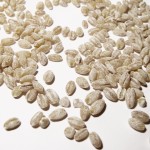 Are you trying to eat more whole grains but want an alternative to whole wheat? Are you trying to lower your blood cholesterol or blood sugar levels? You will be happy to know that barley can be a delicious and nutritious addition to your menu.
Are you trying to eat more whole grains but want an alternative to whole wheat? Are you trying to lower your blood cholesterol or blood sugar levels? You will be happy to know that barley can be a delicious and nutritious addition to your menu.
Most of barley’s health benefits come from its fibre content and the plant substances it contains. Barley contains both insoluble and soluble fibre. Insoluble fibre is needed to prevent and relieve constipation. Soluble fibre can help lower blood cholesterol levels and control blood sugar levels. The plant substances in barley, called trocols, also help lower blood cholesterol levels and lower the risk of cancer and heart disease.
There are three main types of barley:
- Hulless barley – this whole grain has the bran and germ layers intact. It contains the most fibre and nutritional value of all types of barley.
- Pot or Scotch barley – this barley is moderately refined. It contains less fibre and nutrients than hulless, but more than pearl barley.
- Pearl barley – this is the most common type of barley, but is also the most refined. It has most of the germ and bran layer removed, so it contains the least amount of insoluble fibre and has the lowest nutritional value.
Hulless barley kernels can be found in some bulk food stores, whereas pot, Scotch and pearl barley are found in most grocery stores. Hulless barley flour and rolled hulless barley can be found in some grocery stores in Saskatchewan.
Here are some ways to include barley in your diet:
- To cook, add 250 mL (1 cup) of barley to approximately 500 mL (2 cups) of boiling water. Reduce the heat to low, cover and simmer until tender. Pearl barley takes about 45-60 minutes to cook, pot barley takes about 60-75 minutes and hulless barley takes about 75-90 minutes. You may want to cook a large batch of barley and freeze it in smaller portions. It is then ready to add to casseroles, soups and salads.
- Cook barley in broth with vegetables to create a barley pilaf. This can replace rice, pasta and potatoes as a side dish.
- Use rolled hulless barley as a hot cereal or add it to baking in place of oatmeal.
- Use hulless barley flour in place of some or all of the white flour in muffins, cookies, cakes, pancakes or fruit crisp. It gives a lighter taste and texture to baked products than whole wheat flour.
- Use some hulless barley flour in yeast-leavened breads. Since barley contains very little gluten, some white flour is still needed. Use 80 mL (1/3 cup) barley flour and 180 mL (2/3 cup) white bread flour to replace 250 mL (1 cup) of bread flour.
Barley can be a tasty and versatile addition to any menu. Choose the hulless barley whenever possible for the greatest health benefits. For more information on using barley, contact your local Public Health Nutritionist. If you cannot find hulless barley flour or rolled hulless barley locally, you can order it from Golden Grains Farm in Dinsmore, (306) 846-4722.
WRITTEN BY THE PUBLIC HEALTH NUTRITIONISTS OF SASKATCHEWAN
Originator: Sheri Taylor






